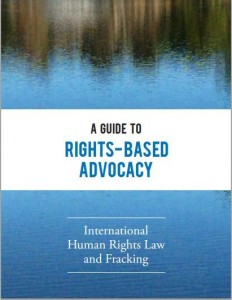“Guide to International Human Rights Law and Fracking” now available
From a Summary by Jessica Ernst, Jessica Ernst Blog, June 12, 2015
Guide to International Human Rights Law and Fracking by the Sisters of Mercy International Association: Global Action, and Aine O’Connor, RSM Mercy Global Action Co-ordinator at the United Nations, writers and editors include Rita Parks and Elizabeth Willmott-Harrop, June 12, 2015
INTRODUCTION
The hydraulic fracturing (fracking) industry is booming. So are industry cash settlements and property buyouts for people who say fracking has ruined their water, lowered their house prices and destroyed their quality of life. From farm animals dropping dead overnight to low birth weights in human infants, fracking is becoming synonymous with harm, and the process is seen to harm ecosystems, as well as animal and human health.
Often overlooked in the fracking debate is the fact that fracking can breach international human rights law in multiple ways. What can also be overlooked is the fact that existing international human rights mechanisms are available to people on the ground in asserting their rights.
This Guide aims to contribute to the debate on fracking by outlining how International Human Rights Law can empower and reposition people and communities as rights-holders, providing an extensive overview of accountability mechanisms to address threats or harms from fracking. These can be manyand include violations to the right to health, water, food, housing, freedom of information and expression, the rights of children, and the cultural and collective rights of indigenous peoples, ethnic minorities, and peasant communities.
As with all new and emerging technologies, the risks and negative impacts of fracking are also new and emerging, and the legal framework must keep pace with these consequences.
This challenges civil society actors to contribute to the dialogue and debate about what is appropriate in the name of economic progress and the thirst for fuel and, conversely, what must be halted or changed.
We hope that this Guide will contribute to the improvement of environmental, social and economic policy with regard to fracking and, indeed, as policy applies to any other extractive technology or activity seeking to affect or exploit the natural environment.
As such, this Guide is also a tool for governments as a reminder of their responsibilities both toward their citizens and in preventing rights violations by non-state actors such as extractive industries.
Primarily, however, this is a guide for action by individuals in claiming their rights. Whether you as a reader are an individual affected by fracking in your community, or belong to a campaigning group wishing to highlight global concerns, you can use this Guide to take action.
The Guide focuses on how the existing international human rights framework can be applied to the issue of hydraulic fracturing with a view to understanding the impact of fracking on human rights and how action can prevent human rights violations.
The business sector can also benefit from using this Guide to become better informed about its responsibilities in upholding people’s rights and respecting the Earth.
This Guide is produced by the Sisters of Mercy (NGO), Mercy International Association: Global Action, enjoying special consultative status with the Economic and Social Council (ECOSOC) of the United Nations. We wish to thank Franciscans International for their consultation in its development.
>>> A Colorado State scientist called the state’s oil and gas boom “a death sentence for soil.” <<<
In a submission to the Parliament of South Australia, Natural Resources Committee Inquiry into Unconventional Gas (i.e., fracking) in February 2015, Anne Daw summarized the impact on the community:
“Valid community concerns exist in regard to environmental, economic, water security, sustainable food bowl, local, national and international export markets, and tourism. People are concerned with demographic changes, associated strain on community services, loss of lifestyle as they now know it, and insecurity regarding their futures. Impacts on landscape, triggering of earthquakes, seawater intrusion and the fact that the South East is built on limestone with a number of caves, fault lines, sinkholes and subsidence … Limestone subsidence and sinkhole formation are hastened by unconventional gas activities.”
Access to basic services like quality water and sanitation are indivisible from the realization of the right to adequate housing. If fracking can impact people’s access to water of adequate quantity and quality, it in turn impacts the right to adequate housing.
…
2.5 FRACKING AND THE RIGHT of access to information
Due to secrecy in the fracking process and policies of nondisclosure, citizens and regulators cannot always know all the risks or indeed whether negative trends in health and environment, for example, are directly related to fracking. There are two major ways in which practices of hydraulic fracturing often lack transparency:
• The identity of chemicals injected underground can be kept hidden from the public, and
• Lawsuits against drilling companies are often resolved through confidential legal settlements.
…
Early Warnings, Later Lessons
The human rights impacts of fracking are both far-reaching and severe.
See also: www.FrackCheckWV.net

